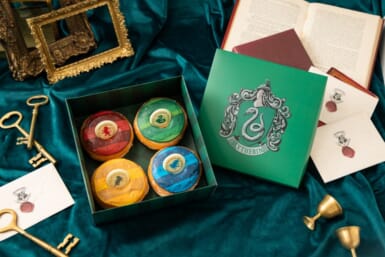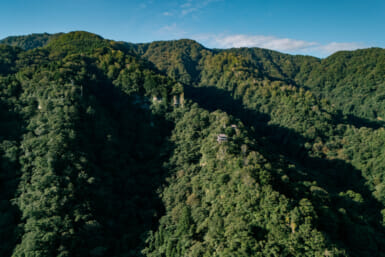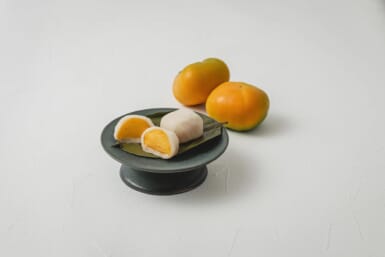by Debbie Marcus
Allen Sweeny’s reputation as a talented cook followed me around for some time before I actually had the good fortune of meeting him in person. I was not disappointed. He is indeed a good cook and, what’s even better, his wife Donna is equally adept in the kitchen.
Allen and Donna were in the midst of compiling a cookbook when they were transferred from New York City to Tokyo. Their book, entitled “Park Avenue Cheap,” had to be shelved temporarily because of the move, but now they are thinking of completing the book while living in Tokyo and revising the title to read “Roppongi Expensive”!
The Sweenys are both very successful business people. Donna is the Training Director in the Consulting Department of Arthur Andersen & Co. Allen is the Executive Vice President of Yamazaki Nabisco Co., Ltd.
This month sees the finalization of a merger involving Allen’s company, Nabisco, and R.J. Reynolds Industries. R.J. Reynolds, the second largest U.S. tobacco company, is acquiring Nabisco, the fourth-largest U.S. food company, for a total of $5 billion. Reynolds is already heavily ensconced in the food business as the owner of Del Monte, Kentucky Fried Chicken, Grey’s Poupon Mustard, Sunkist Orange Juice, Canada Dry beverages, A-1 Sauce and Hawaiian Punch.
Nabisco, the world’s leading manufacturer of biscuits and cookies, makes name products such as Oreo Cookies, Ritz Crackers, Planters Peanuts, Baby Ruth candy bars, Shredded Wheat cereal and Fleischman’s margarine.
Allen Sweeny is no stranger to food, having been involved with it throughout his business career. He has also been exposed to many types of food because of international work. When he lived in South America, Spain and Europe, he experimented with all kinds of food and upon returning to the United States would try to duplicate what he had ealen. Every weekend was spent testing recipes in his kitchen on Park Avenue in New York City.
One of the Sweenys’ favorite weekend dishes when friends visit is called Almejas Marbella, a dish that Allen first tasted during a visit to Marbella, Spain. This dish should only be eaten with garlic lovers (a lot of garlic has to be used), and a cold white wine is imperative with Almejas (so invite a few of your favorite winos, too).
Allen shops early in the morning for the clams, brings them home and puts them in a large uncovered bowl of very cold fresh water. Then he puts the bowl in the refrigerator for a while until they clean themselves. You can keep them in the refrigerator overnight if necessary, but it is better to buy and cook the same day. This recipe is for four people and is so easy and delicious you won’t believe it.
ALMEJAS MARBELLA
- Take a big pot with a lid (a spaghetti pot is good) and coat the bottom of the pan with 1 tablespoon of oil.
- Press 4 large cloves of garlic into the pan. Slightly brown the garlic. Then add about 2 dozen large clams and 15-20 small clams.
- Sprinkle with chopped parsley to taste and pour in 1/4-1/2 cup white wine.
- Turn heat medium high, cover and cook until all clams are open. Stir with a big spoon occasionally.
- Dump into one big bowl. Serve with a big serving spoon. Spoon out clams and liquid into individual soup bowls. Serve with cold white wine, salad, hot French bread—which you dip into the gravy—and a small fork.
* * *
Allen lived in South America for many years and while there he got hooked on Chimichurri sauce and has been ever since. It is a zesty sauce that is used in Argentina to pour over grilled steaks and spicy sausages called chorizos. It is also a great marinade for economical cuts of beef.
For example, without any special treatment, flank steak can be a very tough (albeit cheap) cut of beef, but marinating does wonders for both its texture and flavor. For four people you will need a flank steak of about 1 kilo.
- Place the steak in a bowl with half a cup of olive oil, two tablespoons of red vinegar (if you have an opened bottle of red wine, substitute that for the vinegar), two tablespoons minced onion.
- Let steak marinate for at least four hours in this mixture turning it occasionally.
- Broil the steak for 3-6 minutes on each side.
- When the steak is done, cut it against the grain into thin slices, place the slices on a warm platter and serve it with:
CHIMICHURRI
In a large bowl combine:
2 cups olive oil
1 cup vinegar
2 cups chopped onion
4-6 cloves garlic, pressed
1 cup finely chopped parsley
2 Tbsp dried oregano
1 Tbsp cayenne pepper
2 Tbsp ground black pepper
Mix all the ingredients until they are well blended, and serve at room temperature. Be sure to pass French bread pieces along with this sauce as it’s great for dunking. If you have any leftover sauce, it will keep for several weeks in the refrigerator.
* * *
I’ve often said that you can always tell a man by his paella and Allen Sweeny’s is superb! He learned to cook paella while living in Spain about 15 years ago. Paella actually takes its name from the large two-handled pan that it is cooked in. Any large 12-14 inch frying pan can be substituted, and the dish can be as simple or as elaborate as you wish. In Spain, paellas vary in the ways in which they are prepared from province to province, thus taking the names of Paella Valenciana, Paella Andalusia, etc. However, in Tokyo we have our own
PAELLA SWEENY
4 large or 8 small hot sausages (Italian, Portuguese or Spanish)
12 chicken drumsticks
2 dozen little clams
2 dozen mussels
1/2 cup finely chopped onions
1 tsp finely chopped garlic
1 medium size sweet red pepper, seeded, deribbed and cut into strips
1 large tomato, peeled and finely chopped
1/2 tsp ground saffron
1 box frozen green peas
1 box frozen artichoke hearts
3 cups rice
6 cups boiling water
1/2 cup olive oil
1. Pour 1/4 of olive oil into the frying pan and heat until a light haze forms.
2. Brown the 12 drumsticks evenly on all sides and set aside to drain on a paper towel.
3. Cut the sausages into 1-inch pieces and brown until crisp on all sides and then set aside to drain on a paper towel.
4. Plunge the tomato in boiling water until its skin cracks. Remove, cool under cold water and peel off the skin.
5. Cut the tomato in small cubes and together with the chopped onions, garlic and two strips of the red pepper which have also been chopped, add them to the pan with another 1/4 cup of olive oil.
6. Cook them slowly over a moderate heat, constantly mashing all the ingredients together until they form a loose paste. At this point, you will have a “sofrito” which is the base for any Spanish type stow dish.
7. About a half hour before you plan to serve the paella, preheat the oven to 400°F (200°C).
8. Add the six cups of boiling water and the saffron to the sofrito and stir thoroughly.
9. Dump in the 3 cups rice and stir gently, taste for seasoning and salt if necessary.
10. Add and arrange the sausage, chicken, clams, mussels and artichoke hearts in the pan, array the strips of red pepper and then sprinkle the box of frozen peas across the top.
11. Set the pan in the oven and bake uncovered for 25 to 30 minutes. At the end of this time the rice should have absorbed all the liquid. If not, continue to bake for a few more minutes. The paella should not be stirred once it has been put in the oven.
12. Once the liquid has been absorbed, remove the pan from the oven, and let stand for five minutes while covered with a clean kitchen towel. Remove the towel and serve. Serves 8 people.
* * *
Donna Sweeny, a real charmer both in and out of the kitchen, learned how to cook at her mother’s Italian knee. When fresh basil is available at the supermarkets in Tokyo, Donna cooks pesto for dinner guests. She claims her pesto sauce is not fattening — but when food tastes this good, who cares?
PESTO SAUCE
(4 servings as a main dish; 8 as a side dish or appetizer)
3 cups fresh basil (approximately 5-6 bunches). The basil must be fresh. Cut off the stems, discard any discolored leaves, wash the leaves and dry thoroughly.
4 cloves fresh garlic, pressed or chopped
1/4 cup grated Parmesan cheese
Approximately 1/4 cup olive oil
1 lb of any kind of pasta. Donna prefers to use shell-shaped pasta because it looks attractive, but any kind is fine.
While pasta is cooking, prepare the sauce. In a food processor with the steel blade, put in the basil leaves, cheese and garlic. Turn on the food processor until all the leaves are pulverized. Add the olive oil in a steady stream until the consistency is that of a runny paste. Salt to taste. Pour over the hot pasta.
Pesto sauce is not cooked. When serving it hot, the heat from the pasta will warm the sauce.
Fresh basil leaves can be frozen. Just wash, dry thoroughly, wrap in aluminum foil and put in the freezer.
Another favorite of Donna’s involving pesto sauce is a
COLD PASTA SALAD
Prepare 1 pound of pasta, running it under cold water alter it is cooked. Put it in a bowl and add a few drops of olive oil; toss to coat the pasta lightly and prevent it from slicking. Pour over the pesto sauce, and mix well. Add 1/4 cup cooked green peas and 1/4 cup chopped pimentos. Refrigerate and serve cold.
Either hot or cold, serve with crusty French or Italian bread, and very, very dry white wine. Yum!
* * *
They are all talented in the Sweeny family. Their son, Steve — a sous chef — gave Donna a mustard recipe that will ruin you forever for the commercial brands. She always keeps a jar in the fridge for the family and makes extra mustard to give as gifts to friends. (This is the kind of friend to have?) After you’ve made it, you’ll wonder how you ever lived without
SWEENY’S SWANKY MUSTARD
4 oz Colman’s dry mustard (has to be Colman’s!)
1 cup red wine vinegar
3 beaten eggs
1 Tbsp flour
1 cup sugar
Stir the dry mustard into the vinegar. Whisk well, trying to take all the lumps out. This is difficult, but try anyway. Refrigerate overnight- In a bowl, beat 3 eggs, 1 tablespoon flour until smooth. Add mustard and vinegar. Mix well. Beat in 1 cup sugar and put the whole mixture in a saucepan. Heat over very low heat until it thickens, about 20 minutes. Stir from time to time. The end result must be the consistency of honey.
Cool and put in a covered jar or jars and refrigerate. Will keep a long time in the refrigerator. Great to use in salad dressings, roasted chicken and grilled fish. Just about anything you can think of.








